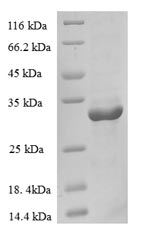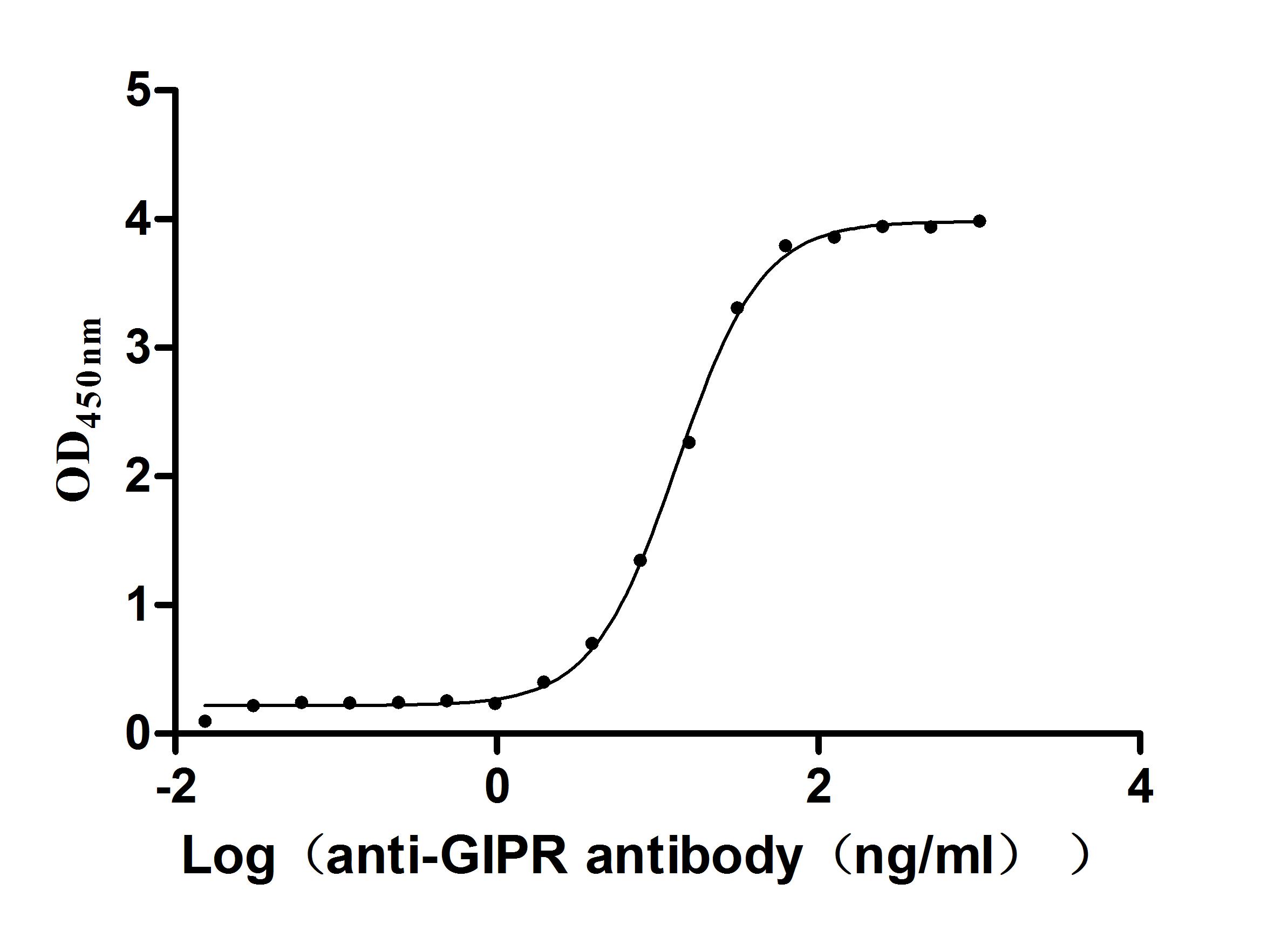Recombinant Human Cellular nucleic acid-binding protein (CNBP)
In Stock-
中文名称:Recombinant Human Cellular nucleic acid-binding protein(CNBP)
-
货号:CSB-EP005637HU
-
规格:¥1344
-
图片:
-
其他:
产品详情
-
纯度:Greater than 90% as determined by SDS-PAGE.
-
基因名:CNBP
-
Uniprot No.:
-
别名:CCHC type zinc finger nucleic acid binding protein; Cellular nucleic acid binding protein; Cellular nucleic acid-binding protein; CNBP; CNBP_HUMAN; CNBP1; DM2; Erythroid differentiation related; PROMM; Proximal myotonic myopathy nucleic acid binding protein; RNF163; Sterol regulatory element binding protein; ZCCHC22; Zinc finger protein 273; Zinc finger protein 9 (a cellular retroviral nucleic acid binding protein); Zinc finger protein 9; ZNF9
-
种属:Homo sapiens (Human)
-
蛋白长度:Full Length of Mature Protein of Isoform 2
-
来源:E.coli
-
分子量:34.6kDa
-
表达区域:2-170aa
-
氨基酸序列SSNECFKCGRSGHWARECPTGGGRGRGMRSRGRGFQFVSSSLPDICYRCGESGHLAKDCDLQEDACYNCGRGGHIAKDCKEPKREREQCCYNCGKPGHLARDCDHADEQKCYSCGEFGHIQKDCTKVKCYRCGETGHVAINCSKTSEVNCYRCGESGHLARECTIEATA
Note: The complete sequence including tag sequence, target protein sequence and linker sequence could be provided upon request. -
蛋白标签:N-terminal 6xHis-SUMO-tagged
-
产品提供形式:Liquid or Lyophilized powder
Note: We will preferentially ship the format that we have in stock, however, if you have any special requirement for the format, please remark your requirement when placing the order, we will prepare according to your demand. -
缓冲液:Tris-based buffer,50% glycerol
-
储存条件:Store at -20°C/-80°C upon receipt, aliquoting is necessary for mutiple use. Avoid repeated freeze-thaw cycles.
-
保质期:The shelf life is related to many factors, storage state, buffer ingredients, storage temperature and the stability of the protein itself.
Generally, the shelf life of liquid form is 6 months at -20°C/-80°C. The shelf life of lyophilized form is 12 months at -20°C/-80°C. -
货期:3-7 business days
-
注意事项:Repeated freezing and thawing is not recommended. Store working aliquots at 4°C for up to one week.
-
Datasheet & COA:Please contact us to get it.
相关产品
靶点详情
-
功能:Single-stranded DNA-binding protein that preferentially binds to the sterol regulatory element (SRE) sequence 5'-GTGCGGTG-3', and thereby mediates transcriptional repression. Has a role as transactivator of the Myc promoter. Binds single-stranded RNA in a sequence-specific manner.; Binds G-rich elements in target mRNA coding sequences. Prevents G-quadruplex structure formation in vitro, suggesting a role in supporting translation by resolving stable structures on mRNAs.; Binds to RNA.; Binds to RNA.; Binds to RNA.; Binds to RNA.; Binds to RNA.
-
基因功能参考文献:
- The s report a previously unknown long noncoding RNA which, together with CNBP, is involved in the fine-tuned regulation of CCND1 mRNA stability, without which CCND1 exhibits, at most, partial expression. PMID: 29199958
- [CCTG]n repeat expansion, differently from the DM1 mutation, does not influence the methylation status of the CNBP gene and other molecular mechanisms are involved in the pathogenesis of Myotonic Dystrophy type 2.. PMID: 29291944
- RNA sequence preferences of unconventional RNA-binding proteins, Nudt21 and CNBP, has been described. PMID: 27956239
- A second point is that DM mutations, although located in noncoding regions, may reduce the expression of mutant alleles, raising questions whether loss-of-function may contribute to the phenotype, or possibly impose a safety limit on knockdown therapies that create or aggravate a DMPK or CNBP deficiency state PMID: 28376341
- CNBP is supporting translation by resolving stable structures on mRNAs. PMID: 28329689
- A G-rich motif in the lncRNA Braveheart interacts with Cnbp to specify the cardiovascular lineage. PMID: 27618485
- The cnbp overexpression rescued the Treacher Collins Syndrome phenotype in a dose-dependent manner by a reactive oxygen species-cytoprotective action that prevented the redox-responsive genes' upregulation but did not normalize the synthesis of ribosomal RNAs. PMID: 27711076
- High CNBP expression is associated with Medulloblastoma. PMID: 26460945
- CNBP overexpression caused increase of cell death and suppression of cell metastasis through its induction of G-quadruplex formation in the promoter of hnRNP K resulting in hnRNP K down-regulation PMID: 24594223
- Arginine methylation of CNBP in the RG motif does not change the subcellular localization but regulates its RNA binding activity. PMID: 24726729
- CNBP are novel antigens for SLE patients and the recognition of CNBP might be differentiated dependent on the level of arginine methylation. PMID: 23642268
- suggested a new possibility of CNBP as a potential anti-cancer target based on CNBP's biological function in c-myc transcription PMID: 23774591
- CNBP associates with the poly(A) binding protein and accumulates in stress granules. PMID: 23285195
- The co-segregation of Myotonic dystrophy type 2 with a recessive CLCN1 mutation provided the explanation for the unusual clinical findings for juvenile onset of myotonia in a 14-year-old female with Myotonic dystrophy type 2 and her affected mother PMID: 22407275
- Myotonic dystrophy 2(autosomal dominant, multisystem disorder caused by a CCTG tetranucleotide repeat expansion located in intron 1 of the zinc finger protein 9 gene (ZNF9 gene) on chromosome 3q 21.3.) described in Israeli Jewish European ancestry. PMID: 22332444
- CCTG repeat expansions in the CNBP gene are responsible for myotonic dystrophy type 2. PMID: 21204798
- Study concludes that DM2 patients from the Netherlands, including a North-African family, harbor a common haplotype surrounding the ZNF9 gene. PMID: 21224892
- These data suggest that Gis2 is functionally orthologous to ZNF9 and acts as a cap-independent translation factor. PMID: 21277287
- ZNF9 expression in myotonic dystrophy type 2 patients is altered at multiple levels. PMID: 20971734
- ZNF9 is abundantly expressed in human myofibres, where it is located in the sarcomeric I bands, and no modification of this pattern is observed in myotonic dystrophy type 2 muscles. PMID: 20102514
- Data identify ZNF9 as a regulator of cap-independent translation and indicate that ZNF9 activity may contribute mechanistically to the myotonic dystrophy type 2 phenotype. PMID: 20174632
- Six of seven of the Zn(2+) fingers from the CNBP protein can be used as substitutes for the Zn(2+) finger in the NH(2)-terminal position of HIV-1 nucleocapsid, and thus support virus replication PMID: 12857921
- The proximal myotonic myopathy phenotype is associated with DM2-(CCTG)(n) expansion mutations. PMID: 15261229
- In twenty-six individuals from a family with DM, the CCTG repeats in ZNF9 were found in normal range. PMID: 15476170
- results show that a single nucleotide polymorphism located in the first intron of the ZNF9 gene is in linkage disequilibrium with the DM2 mutation PMID: 15652222
- Results indicate that the (CCTG)n expansion in the ZNF9 intron does not appear to have a direct consequence on the expression of the gene itself. PMID: 16376058
- the downstream molecular effects of a DM2 mutation are triggered by the accumulation of CCUG repeat tract alone and do not decrease ZNF9 expression at the mRNA or protein level PMID: 16624843
- We present two first-degree relatives with an athletic clinical phenotype, pathological evidence of subsarcolemmal vacuolation, and molecular genetic confirmation of DM2(the molecular defect of the zinc finger protein 9 gene) PMID: 17068784
- PCBP2 and ZNF9 stimulate translation of the ornithine decarboxylase internal ribosomal entry site . PMID: 17327219
- These data contribute to the clinical and molecular correlation of ZNF9 gene short expansion in myotonic dystrophy. PMID: 18804219
- Validated occurrence of an unusual TG 3' splice site in intron 3. PMID: 17672918
显示更多
收起更多
-
相关疾病:Dystrophia myotonica 2 (DM2)
-
亚细胞定位:Nucleus. Cytoplasm. Endoplasmic reticulum.; [Isoform 1]: Cytoplasm.; [Isoform 2]: Cytoplasm.; [Isoform 4]: Cytoplasm.; [Isoform 5]: Cytoplasm.; [Isoform 6]: Cytoplasm.; [Isoform 8]: Cytoplasm.
-
组织特异性:Expressed in the liver, kidney, spleen, testis, lung, muscle and adrenal glands.
-
数据库链接:
HGNC: 13164
OMIM: 116955
KEGG: hsa:7555
STRING: 9606.ENSP00000410769
UniGene: Hs.518249
Most popular with customers
-
Express system: Mammalian cell
Species: Macaca fascicularis (Crab-eating macaque) (Cynomolgus monkey)
-
Recombinant Human Claudin-6 (CLDN6)-VLPs (Active)
Express system: Mammalian cell
Species: Homo sapiens (Human)
-
Recombinant Human Trophoblast glycoprotein (TPBG), partial (Active)
Express system: Mammalian cell
Species: Homo sapiens (Human)
-
Recombinant Human Dickkopf-related protein 1 (DKK1) (Active)
Express system: Mammalian cell
Species: Homo sapiens (Human)
-
Recombinant Human CUB domain-containing protein 1 (CDCP1), partial (Active)
Express system: Mammalian cell
Species: Homo sapiens (Human)
-
Recombinant Human Serine/threonine-protein kinase receptor R3 (ACVRL1), partial (Active)
Express system: Baculovirus
Species: Homo sapiens (Human)
-
Recombinant Human Carcinoembryonic antigen-related cell adhesion molecule 8(CEACAM8) (Active)
Express system: Mammalian cell
Species: Homo sapiens (Human)
-
Recombinant Macaca fascicularis Gastric inhibitory polypeptide receptor (GIPR), partial (Active)
Express system: yeast
Species: Macaca fascicularis (Crab-eating macaque) (Cynomolgus monkey)




-AC1.jpg)

-AC1.jpg)














